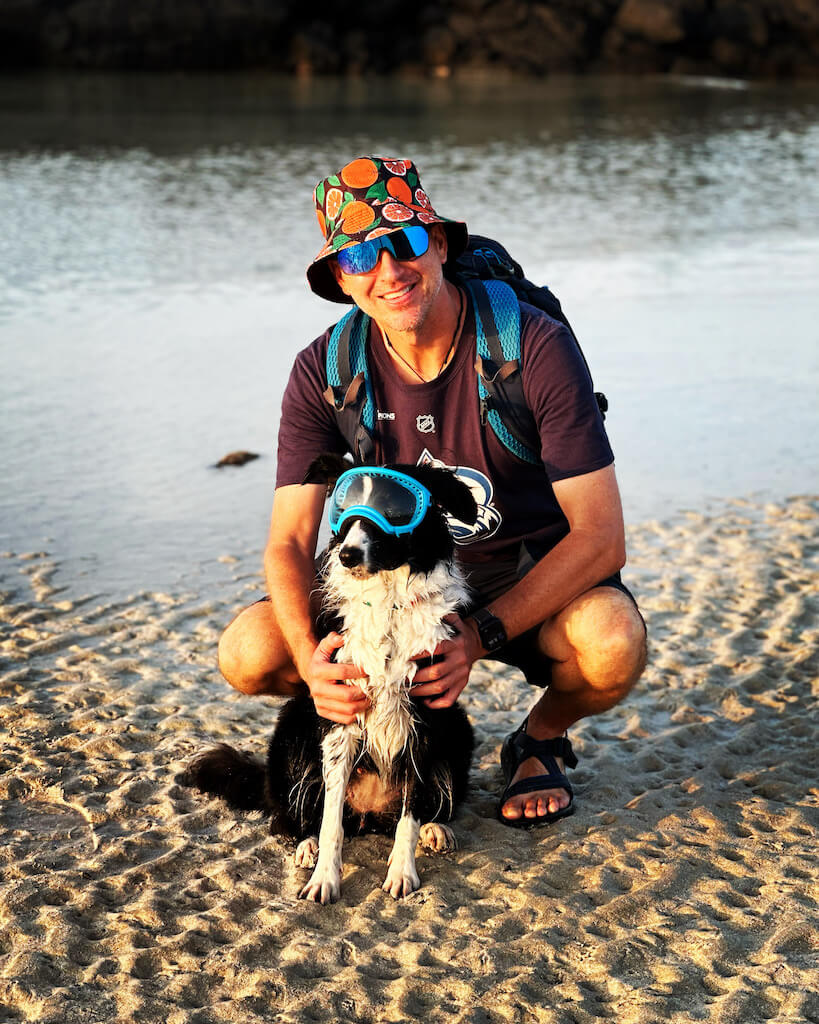Everything you need to know about riding the Fansipan cable car—from where to buy tickets to what it’s really like at the top of Indochina.
Quick heads up: This post may contain affiliate links to gear, hotels, flights, or experiences I’ve used — or genuinely recommend. If you book through one, I may earn a commission at no extra cost to you. Full disclosure here.
Introduction: Riding the Fansipan Cable Car to Vietnam’s Highest Peak
Rising 3,147 meters above sea level, Fansipan Peak is the tallest mountain in Vietnam—and all of Indochina. Nicknamed the “Roof of Vietnam,” it’s long been a destination for climbers and trekkers. But thanks to the Fansipan Cable Car, you don’t need to be a hardcore hiker to reach the summit.
This ultra-scenic cable car journey carries you over the misty Muong Hoa Valley and up into the clouds, where pagodas, statues, and sweeping mountain views await. It’s the perfect way to experience the grandeur of Sapa—even if you’re short on time or energy.

I experienced this in the rainy season of 2024 as part of a 3-day self-guided Sapa adventure, which included trekking, cultural stops, and some surprisingly great food. If you’d like a full breakdown of where to stay, how to plan your route, and what to do beyond Fansipan, check out my full guide:
➡️ Sapa, Vietnam Without a Tour: A Self-Guided Travel Guide
As for the Fansipan cable car portion of our trip, I was surprised by just how smooth, scenic, and atmospheric the entire journey felt—fog and all.
Whether you’re chasing mountain views, ticking off a bucket-list summit, or just want to soak in some cool air above the rice terraces, this guide breaks down exactly how to plan your Fansipan cable car experience: when to go, where to buy tickets, how much it costs, and what to expect at the top.
🎟️ Fansipan Peak Ticket Options & Prices
If you’re wondering whether you need to book Fansipan Cable Car tickets in advance, here’s my advice: yes—especially during weekends or peak season. It’ll save you time, hassle, and the uncertainty of long ticket lines at Sun World Sapa.
During my own rainy-season visit in 2024, I used Klook to book everything in advance and the experience was smooth from start to finish.
What’s Included in the Standard Ticket Bundle?
The ticketing structure at Fansipan is a bit layered. While there are a few à la carte options, I highly recommend going with the full bundle:
- Muong Hoa Monorail – Short ride from Sapa Station to the cable car complex
- Fansipan Cable Car – The main ascent (15 minutes over mountain scenery)
- Fansipan Peak Funicular (1-way) – A mini rail up to the summit monument
👉 Check the latest ticket prices and book through Klook here
This combo costs around $44 USD on Klook and gives you access to the full experience with minimal stairs or confusion.
If you’re on a tighter budget, you can skip the funicular and walk the final stair climb to the summit. That ticket is around $39 USD, but unless you’re feeling extra energetic (or weather is perfect), the small savings probably aren’t worth it.
Where to Buy Tickets
You’ve got two options:
📍 Option 1 – Book Online (Recommended)
• Easiest method, especially for English speakers
• Instant confirmation + mobile barcode access
• Avoid lines at the ticket booth
• Great if you’re planning in advance
👉 Check your Fansipan ticketing options on Klook here
💡 Pro Tip: You only need to book the funicular one way—up. The return walk is actually more scenic, leading you past pagodas, statues, and panoramic viewpoints on the descent.
📍 Option 2 – Buy at Sun Plaza Ticket Booth
• Located in central Sapa, under the iconic yellow clocktower
• Can pay in VND or by card
• Expect longer lines, especially in high season

🚠 How to Get to the Fansipan Cable Car Base
Getting to the Fansipan cable car is a bit more involved than just walking to a station—especially for first-time visitors. It’s a three-part journey that starts in Sapa town and ends nearly 3,000 meters above sea level—high in the clouds.
If you’re staying near the town center (like at Pao’s or near the Stone Church), here’s exactly how to reach the cable car terminal without confusion:
Step 1 – Start at Sapa Station
To begin your Fansipan journey, you’ll first need to make your way to Sapa Station, located in the iconic yellow Sun Plaza building in the heart of town. It’s an easy 10–15 minute walk from most hotels, or a quick ride via taxi or motorbike.
The adventure begins at Sapa Station, located inside the iconic yellow Sun Plaza building—hard to miss if you’re anywhere near the center of town. You can walk there in 10–15 minutes or take a short motorbike taxi if you’re farther out.
Inside, you’ll find a sleek, European-style terminal that connects you to the next leg of the trip: the Muong Hoa Monorail.
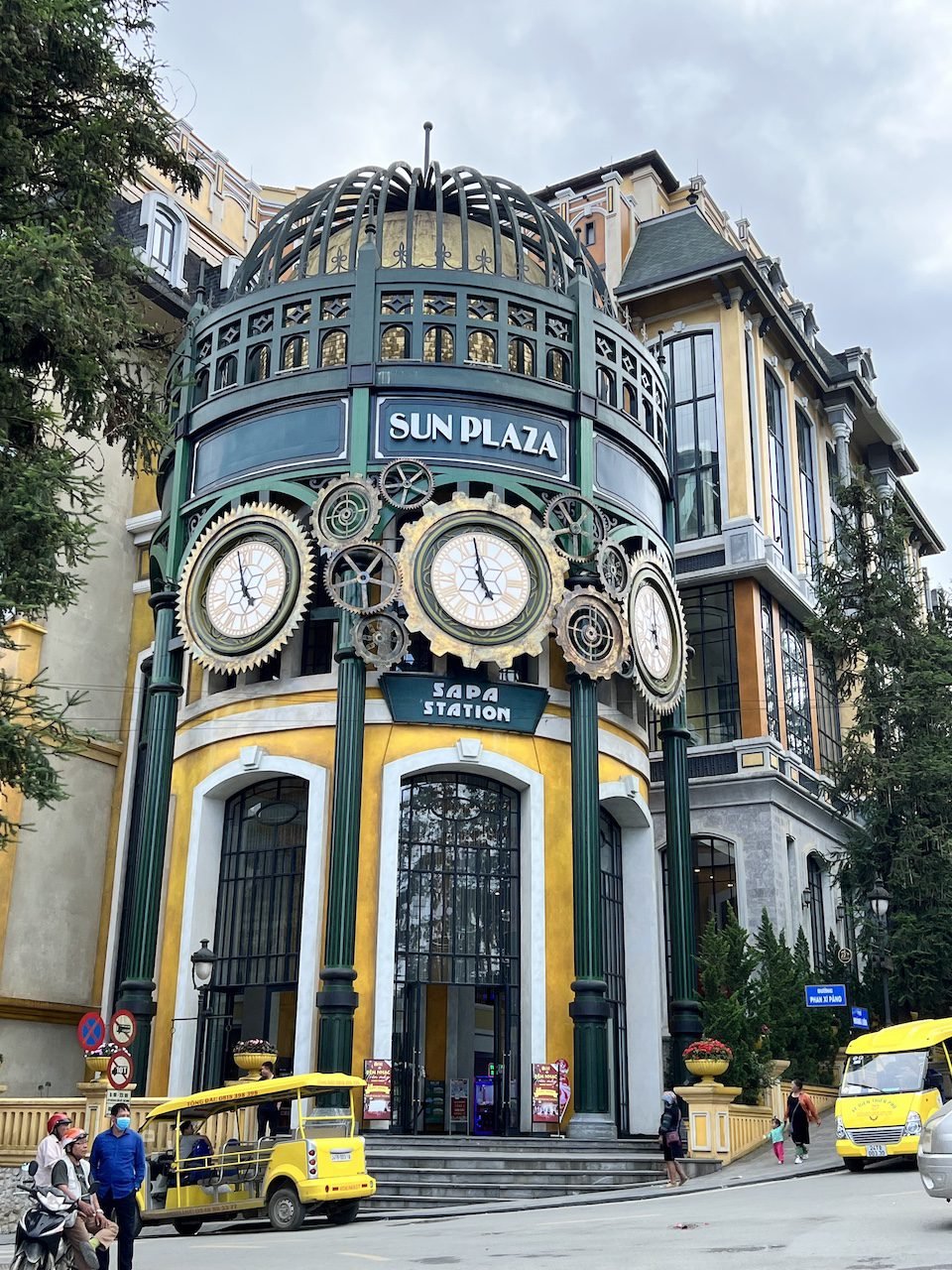

Step 2 – Ride the Muong Hoa Monorail to Sun World
This short but scenic monorail carries you through the lush Muong Hoa Valley and ends at the base of the Sun World Fansipan Legend resort complex. The ride only takes a few minutes but offers sweeping views of the surrounding terraces and mountains—especially on clear days.
Once you arrive, you’ll disembark at a beautifully landscaped station. It’s easy to get distracted here, but don’t wander too far!
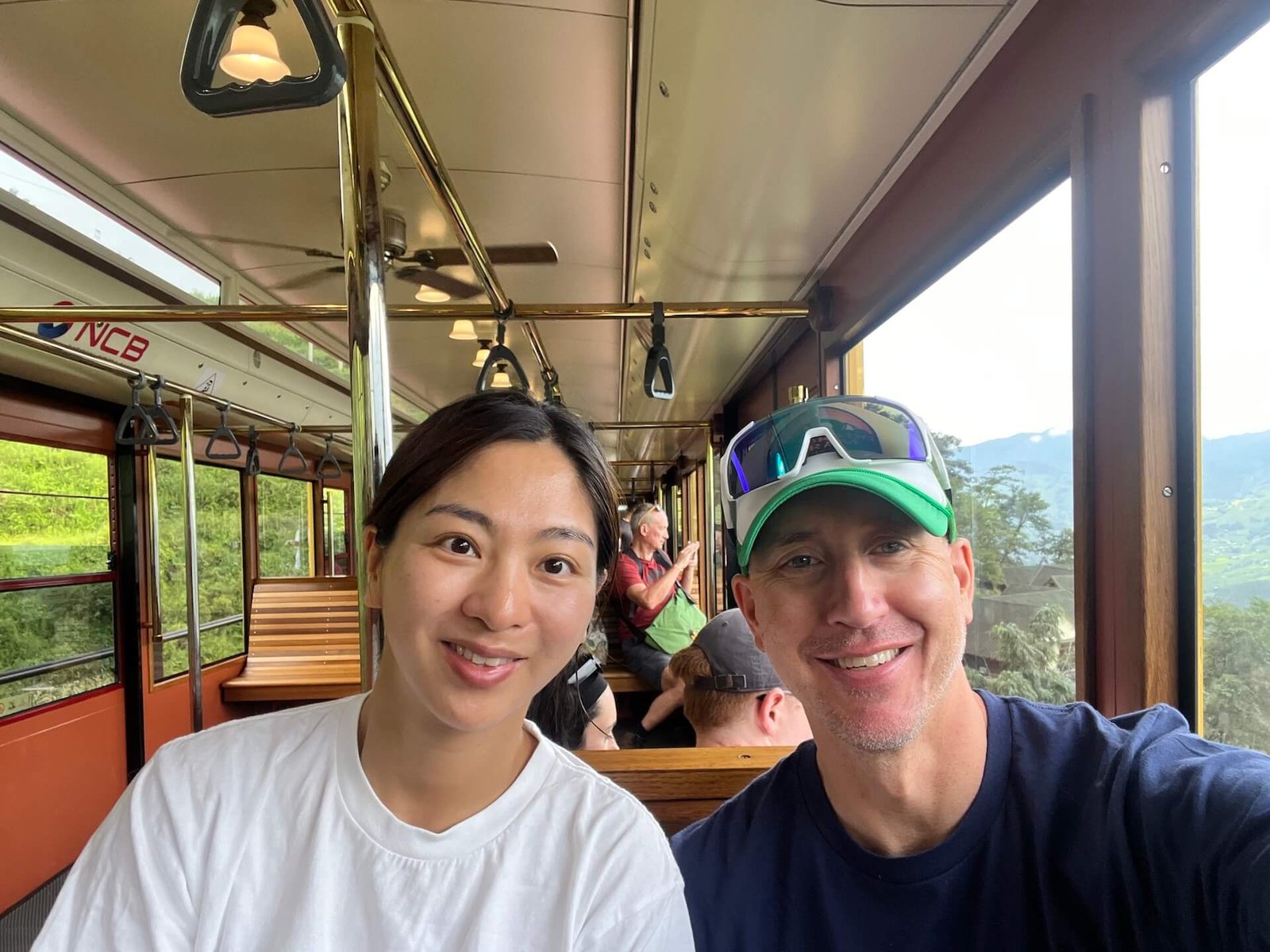
Step 3 – Navigate the Sun World Complex to the Cable Car Terminal
This is the only mildly confusing part of the whole journey: signage inside the Sun World complex isn’t exactly intuitive.
Despite the many signs (as we later realized), we accidentally wandered out toward the garden area, completely missing the main route to the cable car terminal. We ended up having to ask multiple staff members—and eventually got escorted by security—back through a locked gate to get on track.
💡 Tip: During busy times, just follow the main crowd flow toward the station. But if it’s quiet, be proactive. Look for signs pointing to “Fansipan Cable Car” (they do exist!) or ask a staff member to point you in the right direction. It’s not far, just a bit hidden in the chaos of flower gardens, photo ops, and colorful flags.

🎥 Watch: From Sapa Station to the Cable Car Base
Curious what the journey actually looks like? We filmed our full route from the monorail ticket gate at Sun Plaza to the base of the Fansipan Cable Car—including the Muong Hoa Monorail ride and navigating the Sun World complex.
👉 Watch the full clip below to see what to expect on the ground:
🚡 Fansipan Cable Car Experience: What It’s Like
Once you’ve made it through the monorail and navigated the Sun World resort grounds, you’ll arrive at the base station for the Fansipan Cable Car. This is where the real ascent begins—up and over the Muong Hoa Valley, straight into the clouds.
The ride itself is one of the most unique and scenic experiences in Vietnam. Even in rainy-season fog (which we encountered), the journey felt dramatic and peaceful, with mist swirling around the rice terraces and forested slopes below.
⏱️ Ride Duration & Route
- Total ride time: ~15 minutes
- Distance covered: 6.3 kilometers (3.9 miles)
- Elevation gain: ~1,410 meters (4,625 feet)
The cable car is one of the longest and highest in the world, connecting the valley floor to the upper slopes of Mount Fansipan with incredible efficiency. Even better? It’s surprisingly smooth and quiet—ideal for soaking in the atmosphere.
🌄 Views Along the Way
Weather permitting, the views are unreal. On a clear day, expect to see:
- Tiered rice fields cascading down steep hillsides
- Traditional homes tucked into the valley
- Dense pine forests and rugged granite peaks
- Buddhist statues and pagodas perched on distant cliffs
In foggy or cloudy weather, the experience shifts into something dreamier—almost spiritual—with silhouettes appearing and disappearing in the mist.


🎥 Watch Our Cable Car Journey to the Top
Curious what the Fansipan cable car ride actually looks like? Here’s a short video of our ascent—starting from the base station and ending in the clouds. Even on a foggy day, the views and atmosphere were unreal.
☁️ Donuts with chili sauce, foggy windows, and the sound of the gondola climbing into the clouds? It’s all here:
🏯 What to Expect at the Summit
Once the cable car glides into its upper terminal station near the summit of Mount Fansipan, the adventure isn’t over just yet. In fact, this final stretch—from the terminal to the very top of the peak—is packed with atmospheric landscapes, dramatic architecture, and a few surprises along the way.
🧥 Welcome to the Clouds (and the Cold)
As you exit the terminal building, you’ll immediately feel a sharp temperature drop. During our rainy season visit, the outdoor staff were bundled up in winter coats, and the altimeter on my watch read around 9,860 feet (3,005 meters).
Inside the summit station, you’ll find:
- A food court-style café with hot drinks and snacks
- Souvenir shops selling Fansipan gear and trinkets
- Foggy windows framing glimpses of the surrounding peaks
We grabbed a quick coffee (and yes, an inexplicable ice cream) before continuing our journey to the true summit.
🚋 Take the Funicular or Climb the Stairs
To reach the highest point of Fansipan, you have two choices:
- Ride the funicular: A short but scenic rail line officially called the Do Quyen Mountain Train takes you up a steep incline in just a few minutes. Highly recommended if it’s foggy, wet, or you just don’t feel like climbing several hundred stairs.
- Walk the stairs: The full stair route can take 45–60 minutes and is no joke—especially at altitude. It’s scenic but strenuous.
After exiting the cable car, a short uphill walk brings you to the next stage: an endless set of stairs or the entrance to the funicular to the peak of Fansipan.


🏔️ Reaching the Summit of Fansipan Peak (3,143 Meters)
Once you disembark the funicular, there’s still a short walk and another flight of stairs before you reach the summit monument. There’s a small café along this final stretch, sitting right around the 10,300-foot (3,143-meter) mark.
⚠️ Altitude Tip: This is real elevation. We saw a fellow traveler receiving medical help for altitude-related symptoms inside the summit café, so don’t push it if you’re feeling dizzy or out of breath.
At the top, you’ll find:
- The Fansipan Summit Marker—your classic “I made it!” photo op
- A panoramic viewing platform (weather permitting)
- A selection of national flags for posing—though no American or Korean flags, so we went with Vietnam and Myanmar!
It’s a celebratory, high-mountain moment worth savoring—even in the fog.


📸 Crowd Note: During our rainy-season visit, we lucked out with empty cable cars both going up and coming down—but the summit itself was surprisingly busy. Getting a photo at the marker took a bit of patience, as we waited our turn behind other eager travelers. If you visit during high season or mid-day, expect longer waits and a more chaotic scene.
It’s a celebratory, high-mountain moment worth savoring—even in the fog.
⛩️ The Descent: Temples, Staircases & Statues
Rather than ride the funicular down, we took the long way back via the staircase path—and I’d recommend this to anyone physically able. The walk down is peaceful, photogenic, and full of discovery.
Along the way, you’ll pass:
- Towering Buddha statues set against cloud-covered cliffs
- Pagodas and prayer halls perched on ledges
- Winding staircases with dramatic views between the fog
As you descend from the summit back toward the cable car station, take time to explore the sprawling spiritual complex built into the mountainside. You’ll pass temples, incense-filled altars, towering Bodhisattvas, and the iconic Great Buddha—each one adding a moment of reflection to your Fansipan adventure.
Eventually, you’ll return to the summit station where you can grab food, warm up, or shop before boarding the cable car back to Sapa.
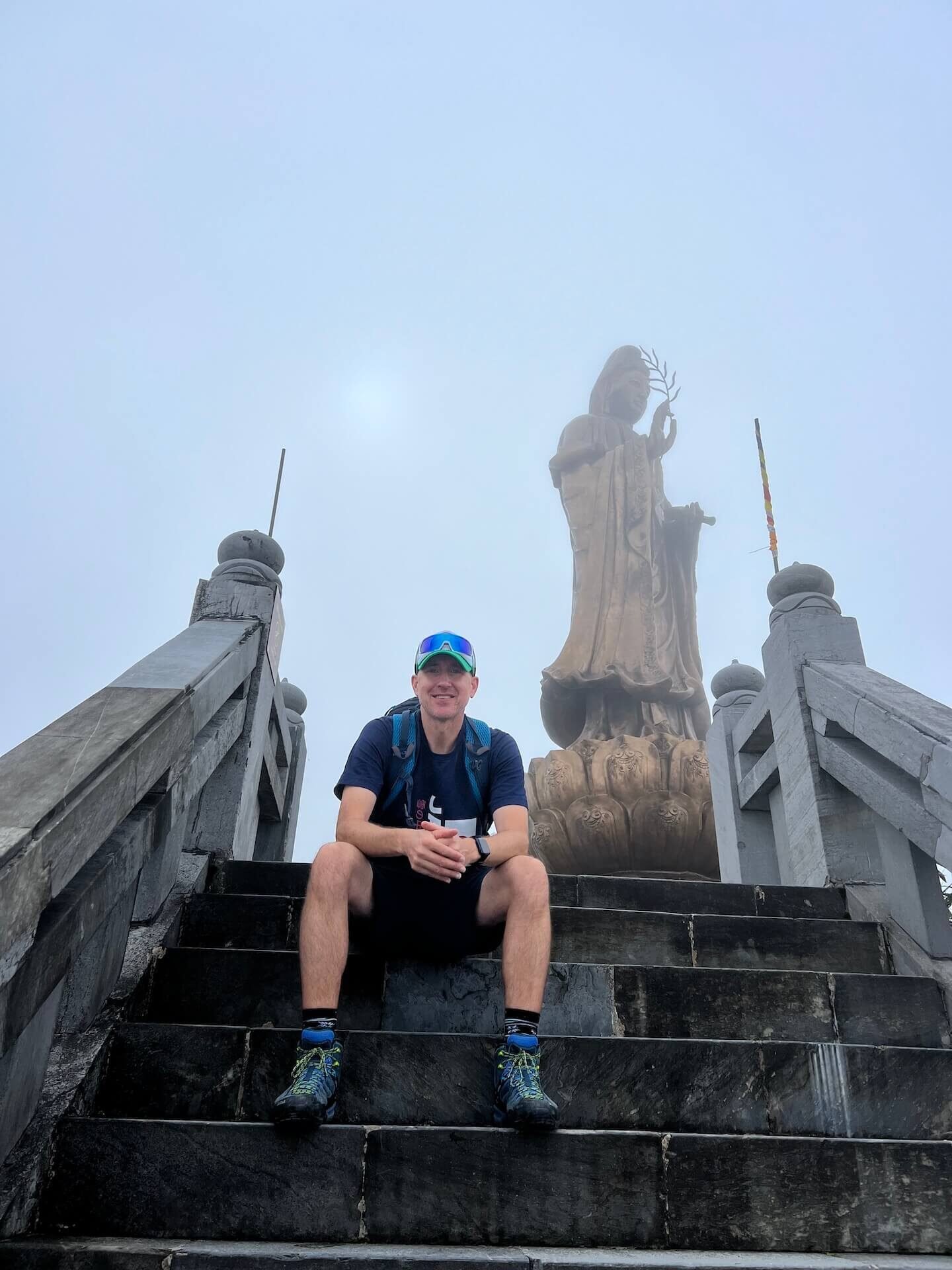

🎥 Watch: Exploring the Summit of Fansipan Peak
From the foggy funicular ride to snapping our summit photo, here’s a quick visual look at what it’s like at the top of Vietnam’s highest mountain. You’ll see us inside the upper café, posing with flags at the 3,143-meter marker, and wandering past misty pagodas and towering Buddha statues on the descent.
💬 Is Fansipan Worth It? My Honest Review
In short? Yes—Fansipan is absolutely worth it.
What makes this peak so special isn’t just its height (though standing at 3,143 meters, it’s one of the highest points in Southeast Asia)—it’s how accessible the entire experience is. You don’t need weeks of training or grueling hikes to get that high-alpine thrill. Thanks to a series of modern rail systems, you can go from downtown Sapa to cloud-piercing temples in just a few hours.
As someone who grew up in Vail, Colorado, I was shocked to realize that we were standing at nearly the same elevation as my hometown. Southeast Asia isn’t exactly known for its altitude—but Fansipan defies expectations.
Years ago, I climbed Mount Kinabalu in Borneo—at 4,095 meters (13,435 feet), it’s the highest peak in Southeast Asia. The views were unforgettable, but the climb was grueling. I still remember waking up the next morning barely able to walk to the bathroom—my legs had fully mutinied. Fansipan, by comparison, delivers the same high mountain vibes—without the multi-day slog or the stairmaster flashbacks.

📍 Want to climb it instead?
If you’d rather earn the summit the hard way, there are guided trekking tours that take you to the top of Fansipan on foot. Most include an overnight stay, a local guide, and the chance to catch sunrise from Vietnam’s highest point.
👉 You can browse top-rated Fansipan trekking tours here or check out a few curated options below from GetYourGuide:
Who Will Enjoy Fansipan Most?
- Photographers – Especially those who love fog, temples, and high-elevation drama
- Families – The entire route is kid-friendly if your little ones can handle the altitude
- Couples & Casual Travelers – It’s a memorable way to spend a day with minimal effort
- Hikers on a Rest Day – If you’ve already tackled a long trek, this is a relaxing follow-up
Is There Any Downside?
If you’re hoping for solitude or a remote mountain escape, you might be surprised by how developed the summit complex is. On clear days, the photo lines can get long, and the vibe leans more theme-park than wilderness.
But honestly? That’s a small price to pay for the chance to stand on the roof of Vietnam—without gasping for breath or climbing for hours.
🧳 Fansipan Travel Tips: What to Pack & Know Before You Go
Even though the Fansipan Cable Car makes reaching the summit easy, the high elevation and unpredictable weather mean a little prep goes a long way. Here’s what you should know to stay comfortable, safe, and photo-ready at the top of Vietnam.
🧥 Dress for Altitude & Mountain Weather
Don’t let Sapa’s mild town temps fool you—once you’re up on the mountain, it can feel like a different season.
- Bring a lightweight down jacket or warm layers
- A windbreaker or rain shell is smart year-round
- Gloves or a beanie aren’t a bad idea in cooler months (Dec–Feb)
Even in July, we saw Fansipan staff bundled up in heavy coats.
📸 Camera & Smartphone Tips for the Summit
Between the elevation change and the foggy air, your camera might fog up—literally.
- Keep your camera or phone in your pocket or bag before stepping out into colder air
- Wipe your lens regularly
- Overcast skies + cloud cover = dreamy, moody shots (embrace it!)
- A mini tripod can help with low-light selfies
🧃 Hydration & Altitude Awareness
At 3,143 meters (10,314 ft), some visitors feel a little lightheaded or winded.
- Drink plenty of water before and during your trip
- Take your time walking the stairs at the summit
- Skip the funicular down only if you’re feeling good
- If you have heart or lung conditions, check with your doc beforehand
We witnessed someone needing medical help at the summit café—take it slow and listen to your body.
⏰ Best Time to Visit Fansipan
Fansipan can be visited year-round, but weather and crowds vary:
- Morning (before 10 AM) – Often clearer skies and fewer people
- Weekdays – Better chance at having a less crowded cable car
- Rainy season (May–Sept) – Fewer tourists, moody/foggy mountain vibes
- Dry season (Oct–April) – Crisp views, but more crowds
💡 Pro tip: On foggy days, don’t be discouraged—you might rise above the cloud line for some surreal views.
🏁 Final Thoughts: Visiting Fansipan Without a Guide
Trekking to the “Roof of Indochina” used to mean days of hiking and hardcore mountaineering. Now? You can stand at 3,143 meters with a hot coffee in one hand and your camera in the other—all without breaking a sweat.
That doesn’t mean the experience is any less memorable.
Whether it’s the quiet moments walking past misty temples, the sweeping views from the cable car, or the surreal feeling of being that high up in Southeast Asia, Fansipan manages to feel both accessible and epic.
We visited in the rainy season, booked everything in advance, and managed to have the cable car to ourselves on the way up and down. (Zero guarantees that’ll happen during peak season—but it was definitely a bonus.)
Would I recommend Fansipan to other independent travelers? Absolutely.
It’s one of those rare touristy attractions that still feels worth it—even when the clouds roll in.
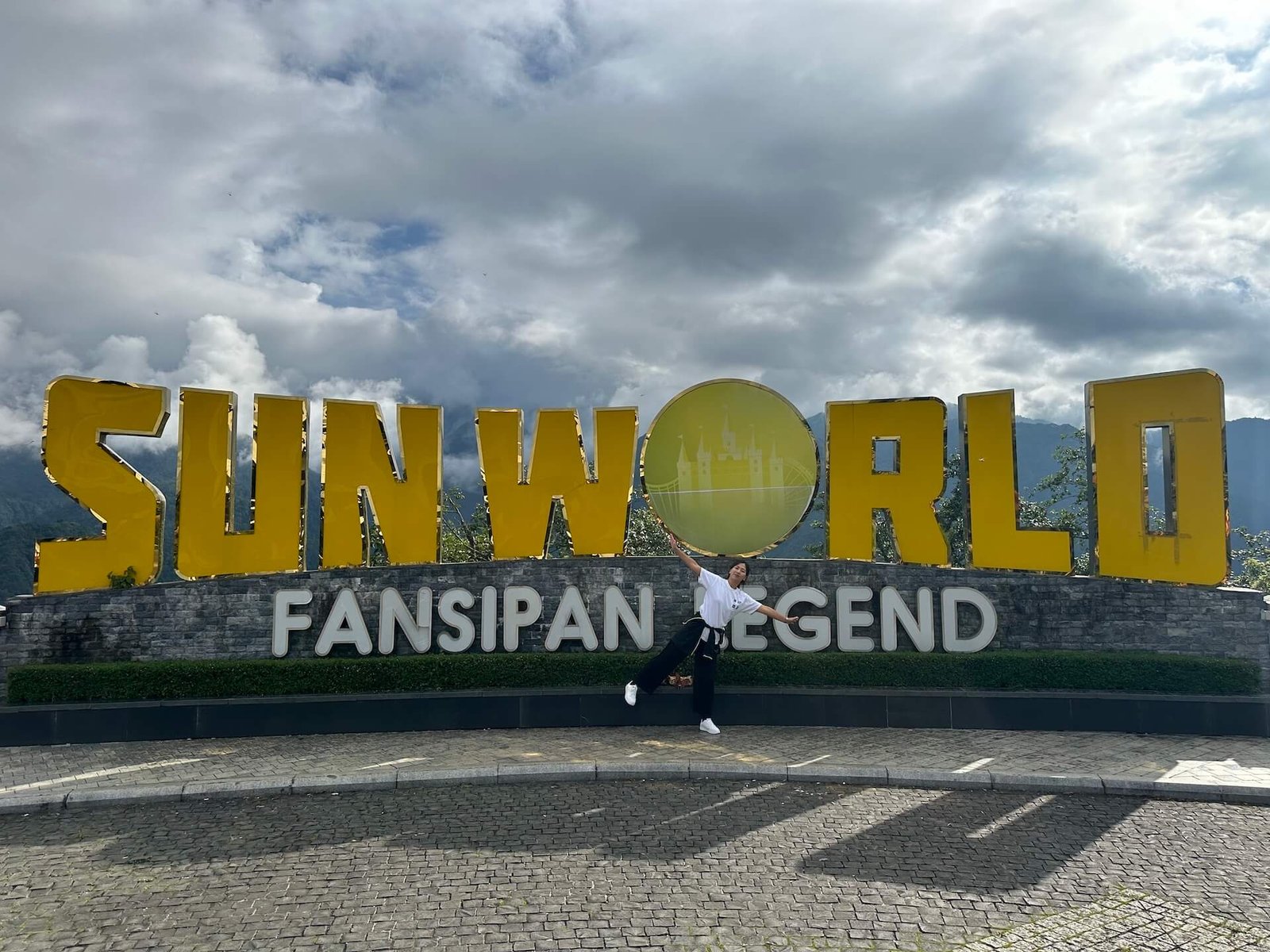
👉 Planning your own trip to Sapa? Don’t miss my full 3-day breakdown:
➡️ Sapa, Vietnam Without a Tour: A Self-Guided Travel Guide
🎟️ Ready to ride above the rice terraces? Don’t wait until the last minute to book:
Check latest Fansipan Cable Car ticket prices on Klook
📶 Want mobile data at the summit? Our eSIM worked perfectly—even at 10,000 feet.
Here’s how to set up your Airalo eSIM for Vietnam
📲 Get your Vietnam eSIM from Airalo here
❓ Fansipan Cable Car FAQs: What to Know Before You Go
Here are some helpful answers to the most common questions travelers have about visiting Fansipan Peak by cable car:
Do I need to book Fansipan Cable Car tickets in advance?
Yes—especially during weekends or holidays. Booking ahead on platforms like Klook saves time and avoids long lines at the Sun Plaza ticket counter. You’ll get instant confirmation and a scannable mobile barcode.
What’s included in the Fansipan Cable Car ticket?
The standard bundle includes three parts: the Muong Hoa Monorail, the main cable car ride, and the one-way funicular to the summit. You can skip the funicular to save a few dollars, but it’s a steep climb—most travelers opt for the full bundle.
How long does the entire Fansipan experience take?
Plan for 4–6 hours round-trip. That includes getting to the base, riding the monorail and cable car, exploring the summit, and returning. If you linger for photos, temples, or a meal at the top, allow extra time.
What should I wear to visit Fansipan Peak?
Even in summer, it can be cold and foggy at the summit. Bring a warm jacket, and wear sturdy shoes with grip—especially if it’s rainy. Layers are key due to the big temperature drop from Sapa town to the summit.
Is the Fansipan Cable Car suitable for kids or older travelers?
Yes! The cable car and funicular make the journey easy for all ages. Just be mindful of altitude—some people may experience lightheadedness or shortness of breath at the summit (3,143 meters / 10,312 feet).
Will I get good views even if it’s cloudy or rainy?
Not always, but the mist can be beautiful in its own right—like floating through a mountaintop temple in the clouds. If possible, go early in the day and check the local forecast. You may also get lucky with cloud breaks at the summit.


